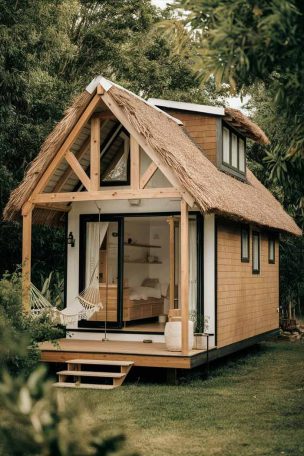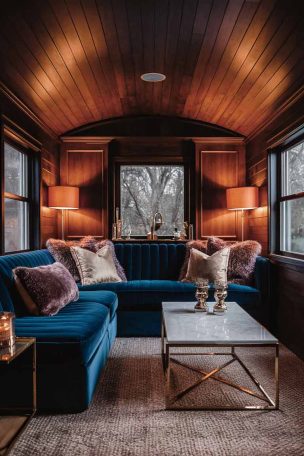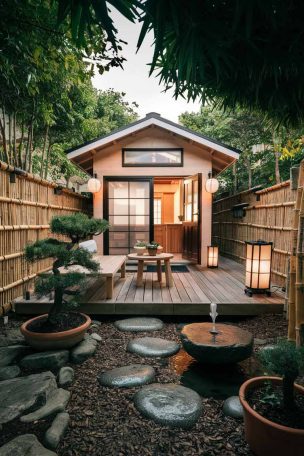The tiny house movement has been making big waves in recent years, challenging our notions of what constitutes a home and how much space we really need to live comfortably.
But what exactly is this movement, and why has it captured the imagination of so many? Let’s dive in and explore this fascinating trend that’s reshaping the way we think about housing.
Definition and Key Characteristics
At its core, the tiny house movement is an architectural and social phenomenon that promotes living in smaller, more efficient spaces. These diminutive dwellings typically range from 100 to 400 square feet—a far cry from the average American home, which clocks in at a whopping 2,600 square feet!
But tiny houses aren’t just about size. They’re a whole philosophy of living. These compact abodes can be rented or owned, set on a foundation or built on wheels for mobility. Many tiny house enthusiasts even design and build their own homes, while others opt for pre-fabricated kits. It’s this flexibility and personal touch that makes tiny houses so appealing to many.
Historical Context
Now, you might think tiny houses are a new fad, but their roots actually stretch back further than you’d imagine. The concept of simple, minimalist living can be traced all the way back to Henry David Thoreau’s “Walden” in 1854. Thoreau’s ideas about living simply in nature laid the groundwork for what would eventually become the tiny house movement.
Fast forward to the 1970s, and we see artists like Allan Wexler starting to explore the idea of compact contemporary living. This period also saw the publication of influential books like Lloyd Kahn’s “Shelter” (1973) and Lester R. Walker’s “Tiny Houses” (1987), which helped popularize the concept of downsized living.
But if we’re talking about the modern tiny house movement, we’ve got to mention Jay Shafer. In 1999, Shafer built his first tiny house – a cozy 110 square feet – in Iowa. He went on to found the Tumbleweed Tiny House Company and co-found the Small House Society in 2002. These efforts really kicked the movement into high gear, inspiring countless others to think small.
Evolution of the Tiny House Movement
Early Years and Growth
The tiny house movement didn’t become an overnight sensation. It grew slowly but steadily throughout the 1990s and 2000s, with enthusiasts starting design-and-construction companies, writing blogs and books, and making media appearances to spread awareness.
Then came the 2009 housing crisis. Suddenly, the idea of living in a small, affordable home became more appealing to many people. This economic upheaval catalyzed interest in alternative housing solutions, and tiny houses fit the bill perfectly.
Mainstream Recognition
By the 2010s, tiny houses were ready for their close-up. TV shows like “Tiny House Nation” and “Tiny House Hunters” debuted in 2014, introducing the concept to a wider audience. These shows didn’t just showcase the homes; they highlighted the lifestyle and philosophy behind tiny living. As a result, what was once a fringe concept quickly became a cultural phenomenon.
Challenges and Criticisms
But it hasn’t all been smooth sailing for the tiny house movement. As it gained popularity, it also faced significant hurdles. Integrating tiny houses into traditional housing markets proved challenging, with issues ranging from high costs (relative to their size) to limited mobility and restrictive zoning laws.
There’s also been some backlash against the romanticized portrayal of tiny living in the media. Critics have raised valid questions about the long-term practicality and sustainability of living in such small spaces. After all, what seems charming for a weekend getaway might feel claustrophobic as a permanent living situation.
Impact on Architecture and Society
Despite these challenges, the tiny house movement has left an indelible mark on architecture and society. Let’s explore some of these impacts.
Influence on Mainstream Architecture
One of the most significant contributions of the tiny house movement has been its influence on how we think about space utilization. Techniques pioneered in tiny homes – like multi-functional furniture, lofted bedrooms, and clever use of vertical space – are now finding their way into mainstream home design.
The movement has also pushed sustainability to the forefront of architectural considerations. Tiny homes often incorporate renewable energy systems, water conservation techniques, and recycled or reclaimed materials. These eco-friendly practices are increasingly being adopted in larger-scale residential and commercial projects.
Moreover, the flexibility inherent in tiny house design has inspired a more adaptable approach to architecture. Features like open floor plans, modular construction, and the use of prefabricated components are becoming more common, allowing homes to evolve with their inhabitants’ changing needs.
Shifting Perceptions of Home
Perhaps the most profound impact of the tiny house movement has been its challenge to our traditional notions of what makes a home. The movement has opened up a world of possibilities by demonstrating that it’s possible to live comfortably and happily in a small space.
This shift in perspective has inspired the development of other unconventional housing types. Accessory Dwelling Units (ADUs), micro-apartments, and co-living spaces are all gaining traction, catering to a growing demand for more flexible and affordable living options.
Social and Economic Implications
The tiny house movement isn’t just about architecture – it’s also about addressing pressing social and economic issues. Tiny houses have been proposed as a potential solution for affordable housing crises in many cities. Some places, like Seattle and Oakland, have even explored using tiny houses as transitional housing for homeless individuals.
On a broader level, the movement reflects societal shifts towards minimalism, sustainability, and a redefinition of success. For many, living in a tiny house isn’t a compromise – it’s a conscious choice to prioritize experiences over possessions and freedom over square footage.
Future of the Tiny House Movement
So, where does the tiny house movement go from here? While it’s impossible to predict the future with certainty, several trends are emerging that give us a glimpse of what might be in store.
Technological Advancements
As technology continues to advance, we’re likely to see tiny houses become smarter and more efficient. Imagine tiny homes with integrated AI systems that can optimize energy use or modular designs that can be easily customized and expanded as needed. The possibilities are endless!
Legal and Regulatory Changes
One of the biggest challenges facing the tiny house movement has been navigating the complex web of zoning laws and building codes. However, as the movement gains mainstream acceptance, there’s a growing push for legal reforms to accommodate these alternative housing options. We may see more cities updating their regulations to make room for tiny houses in the coming years.
Emerging Trends
The tiny house concept is also expanding beyond traditional residential use. We’re seeing tiny structures being adapted for use as office spaces, vacation rentals, and even mobile businesses. There’s also potential for community-based tiny house developments, which could offer the benefits of tiny living along with a sense of community.
Conclusion: The Lasting Legacy of Tiny Living
As we’ve seen, the tiny house movement is about much more than just living in a small space. It’s a philosophy that challenges us to rethink our priorities, impact on the environment, and definition of home.
While it’s clear that tiny houses aren’t for everyone, the movement’s influence extends far beyond those who choose to live in these compact dwellings. By pushing the boundaries of conventional housing, the tiny house movement has sparked important conversations about sustainability, affordability, and the quality of our living spaces.
As we face growing urban populations and increasing environmental pressures, the principles championed by the tiny house movement – efficiency, sustainability, and intentional living – will likely play an increasingly important role in shaping the future of housing and urban planning.
In the end, the tiny house movement reminds us that sometimes, less really can be more. It shows us that with a bit of creativity and a willingness to challenge the status quo, we can create homes that meet our needs and align with our values and aspirations. And that’s no small feat for a movement built on thinking big by living small.





